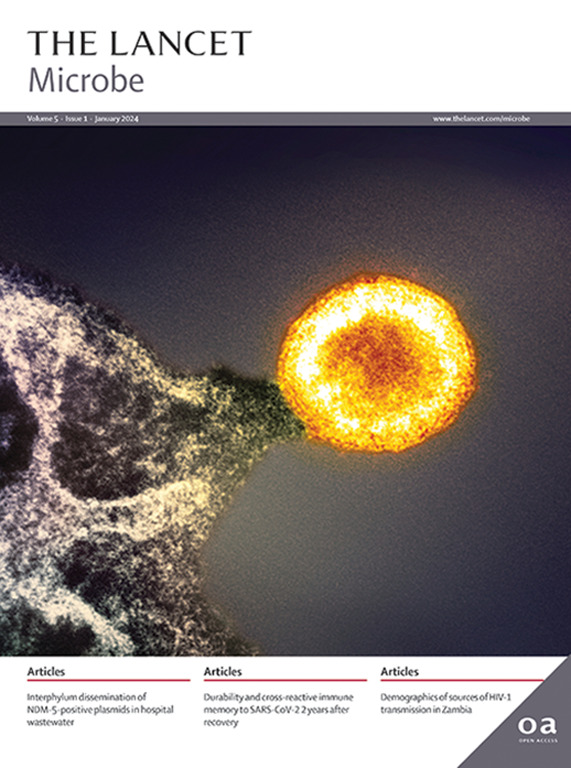艾滋病毒感染者持续超过750天的持续SARS-CoV-2感染的特征:基因组分析
IF 20.4
1区 生物学
Q1 INFECTIOUS DISEASES
引用次数: 0
摘要
背景:免疫功能低下的人可能会出现持续的SARS-CoV-2感染。在这种持续感染过程中积累的几种病毒突变也在突出的关注变体(VOCs)中被观察到。在这里,我们描述了在晚期HIV-1感染患者中持续超过750天的SARS-CoV-2的持续感染和病毒进化。方法:在2021年3月至2022年7月期间,从一名未接受抗逆转录病毒治疗或病毒抑制的艾滋病毒感染者身上采集8份临床标本,推测其于2020年5月中旬首次感染SARS-CoV-2。从每个拭子中提取病毒RNA,并采用基于扩增子的测序方法对SARS-CoV-2进行基因组分析。可变位点在共识和亚共识水平上被表征,系统发育工具被应用于分析病毒进化。利用GenBank中公开可用的SARS-CoV-2序列对测序样本进行背景分析,并确定任何潜在的传播证据。结果:基因组在B.1谱系中形成一个单系集群。在感染过程中观察到68个一致和67个亚一致单核苷酸变异。宿主内时钟率与同期群落序列的宿主间时钟率保持相似(每个位点每年替换6.74 × 10-4次[95%可信区间5.05 × 10-4 ~ 8.54 × 10-4] vs . 6.11 × 10-4次[5.54 × 10-5 ~ 6.66 × 10-4])。在整个感染过程中,突变被分成两个不同的亚群。刺突蛋白基因的10个非同义突变与定义组粒谱系的突变(BA.1或BA.2)相同,其中9个突变在2021年11月之前出现。在整个感染过程中出现的18个替换中,有9个在在线数据库中是罕见的,这表明缺乏从该个体下降的长传播链。解释:在本研究中观察到的刺突蛋白内外的SARS-CoV-2趋同进化表明,这与导致组粒VOC出现的进化过程相似。推断没有进一步感染可能表明在适应单个宿主过程中丧失了传播性。我们的研究结果强调了适当治疗治疗持续性SARS-CoV-2感染的重要性,并对其进行监测,以了解突变如何促进病毒适应。资助:国家卫生研究院普通医学科学研究所、疾病控制和预防中心、国家过敏和传染病研究所、MassCPR和莫里斯·辛格基金会。本文章由计算机程序翻译,如有差异,请以英文原文为准。
Characterisation of a persistent SARS-CoV-2 infection lasting more than 750 days in a person living with HIV: a genomic analysis
Background
People who are immunocompromised can develop persistent SARS-CoV-2 infections. Several viral mutations accumulated during the course of such persistent infections have also been observed in prominent variants of concern (VOCs). Here, we characterise persistent infection and viral evolution of SARS-CoV-2 lasting more than 750 days in a person with advanced HIV-1 infection.
Methods
Between March, 2021, and July, 2022, eight clinical specimens were collected from a person living with HIV, neither receiving antiretroviral therapy nor virally suppressed, and presumed to have been initially infected with SARS-CoV-2 in mid-May, 2020. Viral RNA was extracted from each swab and an amplicon-based sequencing approach was used for genomic analysis of SARS-CoV-2. Variable sites were characterised at the consensus and subconsensus levels, and phylogenetic tools were applied to analyse viral evolution. Publicly available SARS-CoV-2 sequences from GenBank were leveraged to contextualise our sequenced samples and identify any potential evidence of transmission.
Findings
Genomes formed a monophyletic cluster in the B.1 lineage. 68 consensus and 67 subconsensus single nucleotide variants were observed over the course of infection. The intrahost clock rate remained similar to that of the interhost rate in contemporaneous community sequences (6·74 × 10–4 [95% credible interval 5·05 × 10–4 to 8·54 × 10–4] substitutions per site per year vs 6·11 × 10–4 [5·54 × 10–5 to 6·66 × 10–4]). Mutations grouped into two distinct subpopulations present throughout infection. 10 non-synonymous mutations in the spike protein gene were at positions in common with those defining the omicron lineage (BA.1 or BA.2), of which nine were present before November, 2021. Nine of 18 substitutions present throughout infection were rare in online databases, suggesting a lack of long transmission chains descending from this individual.
Interpretation
Convergent SARS-CoV-2 evolution, both in and outside the spike protein, observed in this study suggests parallels with the evolutionary process leading to emergence of the omicron VOC. The inferred absence of onward infections might indicate a loss of transmissibility during adaptation to a single host. Our results underscore the importance of appropriate treatment to cure persistent SARS-CoV-2 infections and monitoring them to understand how mutations contribute to viral adaptation.
Funding
National Institute of General Medical Sciences of the National Institutes of Health, Centers for Disease Control and Prevention, the National Institute of Allergy and Infectious Diseases, MassCPR, and Morris Singer Foundation.
求助全文
通过发布文献求助,成功后即可免费获取论文全文。
去求助
来源期刊

Lancet Microbe
Multiple-
CiteScore
27.20
自引率
0.80%
发文量
278
审稿时长
6 weeks
期刊介绍:
The Lancet Microbe is a gold open access journal committed to publishing content relevant to clinical microbiologists worldwide, with a focus on studies that advance clinical understanding, challenge the status quo, and advocate change in health policy.
 求助内容:
求助内容: 应助结果提醒方式:
应助结果提醒方式:


